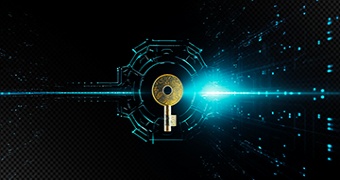We are living in a world where artificial intelligence (AI) is transforming eve....
Encryption During Communication

We all want to have secure communication with each other. Whether we are exchanging personal messages or conducting business transactions online, we want to be confident that our information is protected. The internet has revolutionized communication, but it has also introduced new security risks. Third parties can intercept data if it is not properly secured.
According to a recent IBM report, the global average cost of a data breach in 2023 was U.S. $4.45 million, showing a 15% increase over just 3 years. This highlights the importance of safeguarding our communications with robust security measures and this is where encryption comes in.
In this article, we will delve into some of the most important issues regarding securing communication through the encryption process.
What Is Encryption?
Encryption is the process of transforming readable information, like a message or a file, into an unreadable format using a secret code. It uses methods implemented by technological capacities to encode the message of the information from plaintext to ciphertext. This encoded message can be decoded only after the authorized parties have the key or secret password to decode the message. While encryption does not prevent someone from accessing a message, it makes the content unreadable without the decryption key.

Encryption has been a known practice since ancient times, evolving over the years with various approaches. It is challenging to declare any encryption method as unbreakable, as history has shown that even the most advanced encryption techniques can be compromised under certain conditions. The security of an encryption method largely depends on the length of the ciphertext and the time required to decrypt it.
Two Main Encryption Techniques
There are two primary types of encryption used in modern communication: symmetric and asymmetric encryption.
- Symmetric Encryption: It utilizes a single shared key for both encryption and decryption. It is efficient and ideal for securing communication between two parties who can securely exchange the key beforehand. However, managing key distribution can become complex in scenarios involving multiple users.
- Asymmetric Encryption: It employs a pair of mathematically linked keys: a public and a private key. The public key is widely distributed and allows anyone to encrypt messages intended for a specific recipient. However, only the recipient's private key can decrypt those messages, ensuring a more secure exchange. This method is particularly useful for securing communication channels like websites and email servers.
What Is Encrypted Communication?
Encrypted communication is the transmission of messages or data in a secure format that can only be read by authorized parties. It uses encryption algorithms and keys to convert readable information into unreadable code, ensuring privacy and protection from unauthorized access.
The Benefits of Encryption in Communication
Encryption benefits communication in several ways:
- Confidentiality: Encryption ensures that only authorized parties can access the message content.
- Data Integrity: Encryption safeguards messages from unauthorized modification during transmission. Any alteration to the encrypted data becomes easily detectable, preventing tampering and ensuring the message arrives exactly as it was sent.
- Enhanced Trust: By employing encryption, you demonstrate a commitment to protecting sensitive information. This builds trust with communication partners, especially when dealing with confidential data.
- Secure Transactions: Encryption is the backbone of secure online transactions. Financial institutions and e-commerce platforms rely on it to safeguard sensitive information like credit card numbers and account details.
- Privacy Protection: Encryption empowers individuals to control who has access to their communications. It protects personal conversations, emails, and online activity, safeguarding privacy in a digital age.
- Reduced Risk of Breaches: By scrambling data, encryption significantly reduces the risk of data breaches. Even if hackers manage to steal encrypted data, they face a significant challenge in deciphering it without the key.
The Future of Encryption: Evolving Alongside Technology
The world of encryption is constantly evolving. Researchers are continually developing new algorithms and techniques to stay ahead of increasingly sophisticated hacking methods. Here are some exciting trends shaping the future of encryption:
- Quantum Encryption: The rise of quantum computing poses a potential threat to current encryption standards. Quantum computers could theoretically crack today's encryption algorithms much faster. As a response to the potential threat of quantum computing, researchers are actively developing new encryption algorithms that will remain secure even in this advanced computing environment.
- Homomorphic Encryption: This technology allows calculations to be performed directly on encrypted data, eliminating the need for decryption. This holds immense potential for secure cloud computing and data analysis, allowing authorized users to analyze encrypted data without compromising its confidentiality.
- Post-Quantum Cryptography (PQC): The National Institute of Standards and Technology (NIST) is currently in the process of selecting new PQC algorithms to standardize for future use. This will ensure the availability of robust encryption solutions that can withstand the potential challenges of quantum computing.
- Blockchain Technology: Blockchain, the underlying technology behind cryptocurrencies like Bitcoin, offers unique possibilities for secure communication and key management. Blockchain's distributed ledger system can be used to securely store and manage encryption keys, reducing the risk of loss or compromise.
Encryption for Everyone: Empowering a Secure Digital Future
Encryption is no longer the exclusive domain of tech giants and government agencies. User-friendly encryption tools and services are becoming increasingly accessible to the average user. Here are some ways individuals can take advantage of encryption for their personal security:
- Use Strong Passwords and Password Managers: A strong and unique password is the first line of defense. A password manager can be used to generate and store complex passwords.
- Enable Two-Factor Authentication (2FA): This adds an extra layer of security by requiring a second verification code in addition to your password when logging into accounts.
- Encrypt Sensitive Files: Many operating systems offer built-in encryption tools to protect sensitive files on your computer. Consider using third-party encryption software for additional security options.
- Use Secure Communication Apps: Utilize end-to-end encrypted messaging apps. This advanced protection ensures your messages remain private between you and the recipient.
By embracing encryption and implementing these simple practices, individuals can significantly enhance their online privacy and security.
Conclusion
Encryption is a powerful tool for safeguarding our digital communications. While there are ongoing challenges, the future of encryption is bright. By collaborating, researchers, technology companies, governments, and individuals can develop and implement robust encryption solutions that ensure a secure and trustworthy digital space for everyone.
About the Author
Vlerë Hyseni is the Senior Digital Content Specialist at PECB. She is in charge of doing research, creating, and developing digital content for a variety of industries. If you have any questions, please do not hesitate to contact: support@pecb.com.


